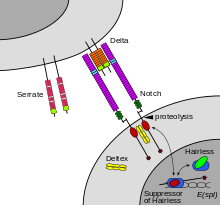
In biology, juxtracrine signalling (or contact-dependent signalling) is a type of cell–cell or cell–extracellular matrix signalling in multicellular organisms that requires close contact. In this type of signalling, a ligand on one surface binds to a receptor on another adjacent surface. Hence, this stands in contrast to releasing a signaling molecule by diffusion into extracellular space, the use of long-range conduits like membrane nanotubes and cytonemes (akin to 'bridges') or the use of extracellular vesicles like exosomes or microvesicles (akin to 'boats'). There are three types of juxtracrine signaling:
- A membrane-bound ligand (protein, oligosaccharide, lipid) and a membrane protein of two adjacent cells interact.
- A communicating junction links the intracellular compartments of two adjacent cells, allowing transit of relatively small molecules.
- An extracellular matrix glycoprotein and a membrane protein interact.
Additionally, in unicellular organisms such as bacteria, juxtracrine signaling refers to interactions by membrane contact.
Juxtracrine signaling has been observed for some growth factors, cytokine and chemokine cellular signals, playing an important role in the immune response.[1] Juxtracrine signaling is also involved in cell specification, or determination of a cell fate determination through a process called induction. In this process, the inducing cells send a signal to responder cells that receive the signal to activate the process of responder's cell fate determination. This cell-to-cell communication plays a role in many developmental processes, such as patterning of the embryos, establishing of cell type diversity, organogenesis, and formation of tissues in various organisms.[2] It has a critical role in development, particularly of cardiac and neural function.
Other types of cell signaling include paracrine signalling and autocrine signalling. Paracrine signaling occurs over short distances, while autocrine signaling involves a cell responding to its own paracrine factors.
The term "juxtracrine" was originally introduced by Anklesaria et al. (1990) to describe a possible way of signal transduction between TGF alpha and EGFR.[1]
- ^ a b Anklesaria, P; Teixidó, J; Laiho, M; Pierce, JH; Greenberger, JS; Massagué, J (May 1990). "Cell-cell adhesion mediated by binding of membrane-anchored transforming growth factor alpha to epidermal growth factor receptors promotes cell proliferation". Proceedings of the National Academy of Sciences of the United States of America. 87 (9): 3289–93. Bibcode:1990PNAS...87.3289A. doi:10.1073/pnas.87.9.3289. PMC 53885. PMID 2333283.
- ^ Perrimon, Norbert; Pitsouli, Chrysoula; Shilo, Ben-Zion (1 August 2012). "Signaling Mechanisms Controlling Cell Fate and Embryonic Patterning". Cold Spring Harbor Perspectives in Biology. 4 (8): a005975. doi:10.1101/cshperspect.a005975. ISSN 1943-0264. PMC 3405863. PMID 22855721.